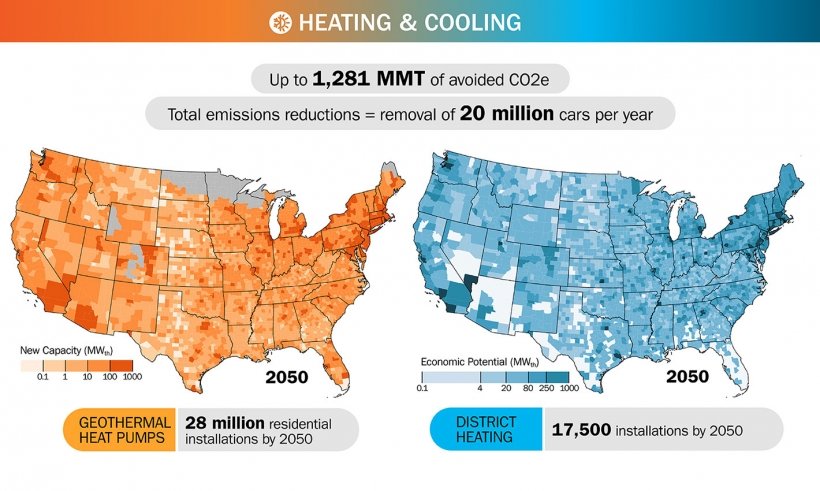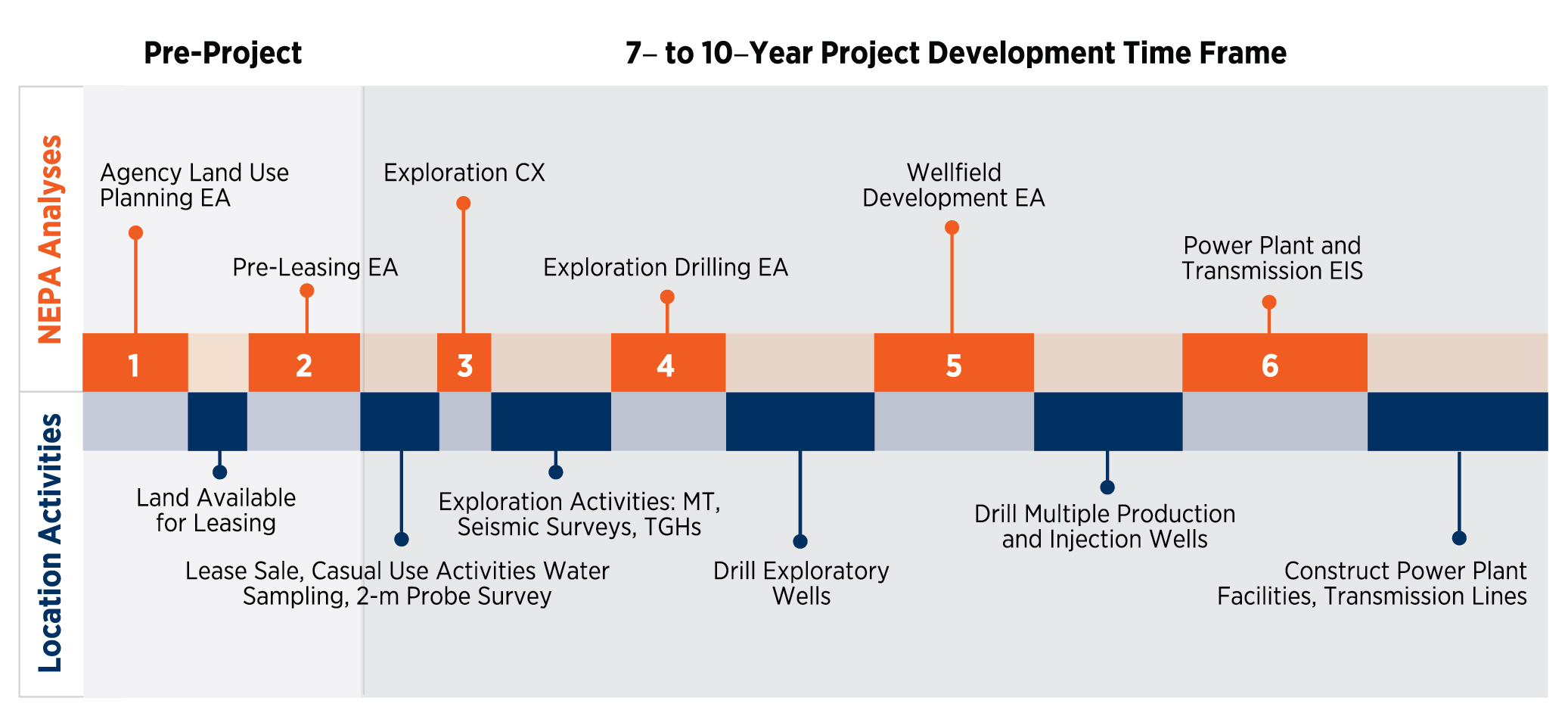Introduction
Geothermal energy is the process by which naturally occurring steam and hot water are used to generate zero-emission energy, at both small- and utility-scale. Current technology drills wells deep into the Earth to harness geothermal resources for use aboveground. While geothermal is currently only four percent of the United States’ electricity production, a recent study by the U.S. Department of Energy (DOE) found that geothermal energy has the potential to meet over eight percent of the country’s projected electricity demand by 2050.
Benefits of Geothermal Energy
A Domestic Energy Source: Geothermal energy can be tapped almost anywhere using the earth as a heat source with heat pump technology. As enhanced geothermal systems (EGS), an emerging technology, develop further they will be able to produce power wherever there is hot rock.
Reliability: Geothermal energy is available 24/7 and is independent of the weather, making it an ideal baseload energy source, and thus a key player in the decarbonization of the United States’ all-of-the-above energy mix. Furthermore, improving technical and economic barriers may also allow geothermal energy to act as a flexible source of power balancing variable-generation capacity.
Minerals Supply: High-demand minerals such as lithium may be found in geothermal brines, the leftover fluid that has circulated through hot rock. Lithium is critical to clean energy and battery manufacturing and extracting a high-demand mineral provides another opportunity to onshore our supply chains. Other solids found in geothermal applications include zinc, silica, and sulfur.
Clean Energy: The carbon lifecycle emissions profile of geothermal energy is comparable to other renewables. Furthermore, geothermal energy can be used for heating and cooling buildings and homes, reducing emissions in these sectors.

Obstacles to Geothermal Development
One of the biggest obstacles to more widespread deployment of geothermal energy are today’s technological limits. The drilling technology and production techniques employed by conventional geothermal are highly dependent on naturally occurring geological conditions such as heat, fluids, and permeability. However, relying on rare naturally occurring geological conditions severely limits the scale of current geothermal energy applications.
The subsurface characteristics of geothermal resources make exploring, discovering, developing, and managing geothermal energy riskier and costlier than other renewable energy technologies. Overcoming these technological limits through innovation is key to expanding the conditions under which geothermal energy can be efficiently recovered and deployed.
Non-Technological Barriers
Land Access and Permitting: Projects that involve multiple landowners (either federal, state, or private), including different surface and subsurface owners (split estate), and multiple federal agencies will increase the complexity of a project and often result in the restriction or delay of geothermal development. Furthermore, cultural, tribal, and biological resources may lengthen the process of review for National Environmental Policy Act (NEPA) compliance for geothermal development, as well proximity to environmentally sensitive areas such as waters, national wildlife refuges and national parks. Geothermal resources in the United States are mostly located in the West on land owned by the federal government, subjecting projects to multiple rounds of environmental review, as shown in Figure 2 below. This contrasts with exploration for oil and gas, which may qualify for categorical exclusions for exploration under current law. Permitting challenges lengthen the development timeframe of projects, which severely impacts the deployment potential of geothermal, with some models suggesting that deployment is reduced by more than fifty percent.

Cost: Geothermal projects face high upfront costs due to the subsurface characterization process. Characterization of geothermal resources involves identifying and locating where the best resources exist. This requires multiple site investigations, including geophysical surveys, thermal gradient holes, full-size diameter drilling wells, among others, that could cost as much as $1 million for each activity, resulting in total costs of $5-10 million just to collect this information. According to a recent DOE report, “It costs about $450 million to initially characterize new next-generation developments and yield a reasonable amount of power,” making this the single largest barrier to scaling up next generation geothermal.
Market Conditions: Given the high upfront costs that geothermal projects face, obtaining a competitive purchase power agreement (PPA) is another large barrier for the deployment of geothermal in the United States. As developers must invest significant capital before they have even obtained a PPA, a competitive agreement with appropriate terms is crucially important for geothermal developers to avoid losses (from pre-PPA sunk costs) and complete the project in a timely fashion.
Transmission: The distance to the nearest transmission line is another determinant to the economic feasibility of permitting and building a geothermal plant. Interconnection costs are paid by the developer and include the costs associated with connecting to the grid, such as transmission and distribution upgrade costs, as well as costs associated with interconnection requests and feasibility and grid connection studies ($50,000-$150,000). Transmission costs refer to the operational costs of transmitting the electricity from the interconnection point to the power purchaser. For a 20 MW geothermal power plant, an operator can pay between $700,000-$2 million annually in transmission costs depending on location.
Recent Federal Action
- In February 2024, the Department of Energy (DOE) selected three projects that will receive up to $60 million funded by the Infrastructure Investments and Jobs Act (IIJA) to demonstrate the efficacy and scalability of enhanced geothermal systems (EGS). These projects are also supporting the goals of DOE’s Enhanced Geothermal Shot, which seeks to cut the cost of EGS 90% by 2035.
- There is a long history of tax credits for geothermal, signed into law by both Republican and Democratic administrations. Recent legislation has extended and modified the renewable electricity production tax credit PTC under Section 45 and the investment tax credit (ITC) under Section 48 to include geothermal energy, with qualifying geothermal facilities to be constructed before 2025. Other incentives include the Clean Electricity Production Tax Credit (45Y) through which geothermal power plants can receive $27.5 per megawatt-hour for the first 10 years of operation, the Qualifying Advanced Energy Project Credit (Section 48C), and a Clean Electricity Investment Tax Credit (Section 48E) for facilities that produce clean electricity.
Conclusion: How Can We Deploy More Geothermal Energy Faster?
- Even though underground heat exists everywhere, many places lack all the necessary conditions to facilitate the recovery of geothermal energy. Innovative technologies, such as enhanced geothermal systems (EGS), closed-loop systems and supercritical systems for very high temperatures are breaking down technological limits that would allow geothermal energy to be a significant resource of firm, flexible power in the U.S. grid.
- There has been longstanding bipartisan support to improve and derisk these technologies, as well as reduce their cost to facilitate the commercialization and deployment of domestic geothermal energy. However, technological advancements are still necessary to improve site selection for more efficient geothermal projects.
- While tax incentives have been a powerful boost to next-generation geothermal power, the duration and structure of these federal incentives are short compared to the development timelines of geothermal projects, making it challenging for developers to depend on them and hindering their effectiveness in deploying geothermal energy at scale.
- Permitting reform is crucial to minimize delays for geothermal projects. While the Bureau of Land Management’s recent adoption of categorical exclusions for geothermal activities on federal lands is a welcome step, onerous reviews, and regulations per the National Environmental Policy Act only delay deployment of further zero-emission geothermal technology.
